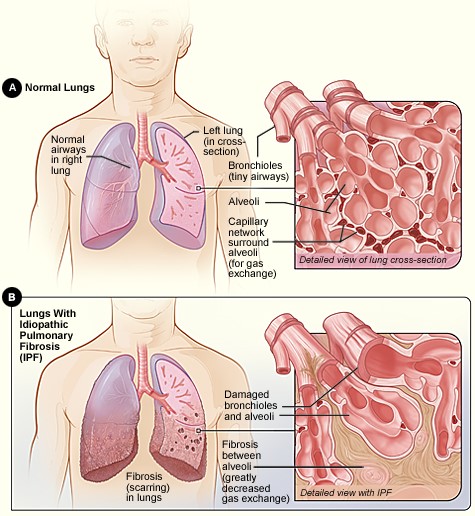Pulmonary Fibrosis Causes and Risk Factors
What causes IPF?
IPF is a type of interstitial lung disease. It is caused by lung tissue becoming thick and stiff and eventually forming scar tissue within the lungs. The scarring, or fibrosis, seems to result from a cycle of damage and healing that occurs in the lungs. Over time, the healing process stops working correctly and scar tissue forms. What causes these changes in the first place is unknown.
To understand IPF it helps to understand How the Lungs Work. In IPF, the scarring makes it difficult to breathe and deliver oxygen from the lungs to the rest of the body. In healthy lungs, oxygen passes easily through the walls of the air sacs, called alveoli, into your and bloodstream. However, in IPF, the scarring makes the walls of the alveoli thicker. The thickened walls of the alveoli make it harder for oxygen to pass into the blood.

What are the risk factors?
You may have an increased risk for IPF because of your age, family history and genetics, lifestyle habits, or your sex.
- Age: The risk of developing IPF increases as you get older. IPF is diagnosed most often in people who are in their 60s or 70s.
- Lifestyle habits: Smoking is a common risk factor among people who have IPF.
- Sex: IPF is more common among men than women.
- Family history and genetics: Your risk for IPF is higher if a first-degree relative, such as a parent or sibling, has IPF. The specific genes you may make you more likely to develop IPF, especially if those genes contain certain changes, or mutations. To date, mutations in more than 10 different genes have been linked to an increased risk for IPF.
Your genes can put you at risk for IPF in a few ways.
Scientists have found that mutations in certain genes are common among people who have IPF. Some of these genes help the body make and , which are important for healthy lung function. One gene, called MUC5B, makes a mucus protein that helps clear harmful substances, such as , from the lungs. Having a mutated MUC5B gene increases your risk for IPF more than other genes.
Mutations in the TERT and TERC genes are also common in people who have IPF. These genes help protect the DNA in our cells as they divide over our lifespans. The genes do this by producing an enzyme called telomerase. More research must be done to understand why these mutations contribute to the development of IPF.
Learn more about ongoing research we support to better understand how certain gene mutations may cause pulmonary fibrosis.
Can I prevent IPF?
Currently, there are no screening methods to determine who may develop IPF. If you have certain risk factors, especially a family history of IPF, your doctor may ask you to have a lung function test or an imaging test, such as a high-resolution chest CT scan, to look for scarring in the lungs.

